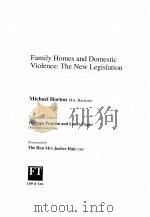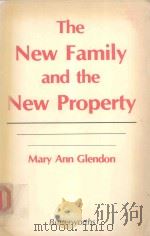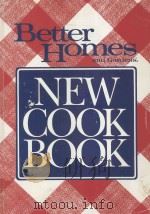《FAMILY HOMES AND DOMESTIC VIOLENCE:THE NEW LEGISLATION》
| 作者 | 编者 |
|---|---|
| 出版 | LAW & TAX |
| 参考页数 | 302 |
| 出版时间 | 1996(求助前请核对) 目录预览 |
| ISBN号 | 无 — 求助条款 |
| PDF编号 | 812921628(仅供预览,未存储实际文件) |
| 求助格式 | 扫描PDF(若分多册发行,每次仅能受理1册) |

Chapter 1 Background to the Legislation1
1.1 The need for reform1
1.2 The Law Commission Report1
1.3 The Home Affairs Select Committee Report2
1.4 The government's response3
1.5 The Family Homes and Domestic Violence Bill4
1.6 The Family Law Act 1996: Course through Parliament6
1.7 Implementation of Part Ⅳ8
1.8 Transitional provisions8
1.9 Statutory interpretation9
Chapter 2 Overview of Part Ⅳ: Key Concepts11
2.1 Outline of Part Ⅳ: a new code11
2.2 Associated persons12
2.2.1 When is the concept used?12
2.2.2 The definition of associated persons12
2.2.3 Spouses or former spouses13
2.2.4 Cohabitants or former cohabitants13
2.2.5 People sharing accommodation: s 62(3)(c)17
2.2.6 Relatives22
2.2.7 Engaged or formerly engaged couples23
2.2.8 Parents and persons who have or have had parental responsibility: s 62(4)25
2.2.9 Parties to family proceedings26
2.2.10 Persons connected through adoption: s 62(5)28
2.2.11 Comment31
2.2.12 Hansard32
2.3 Relevant child34
2.3.1 When is the concept used?34
2.3.2 Definition of the term 'a relevant child'34
2.3.3 Comment35
2.3.4 Hansard35
2.4 The courts with jurisdiction under Part Ⅳ36
2.4.1 Definition of 'the court'36
2.4.2 Judge or district judge?36
2.4.3 Appeals37
2.4.4 Allocation and transfer of proceedings under Part Ⅳ38
2.4.5 When might the magistrates' courts be inappropriate?39
2.4.6 Comment41
2.4.7 Hansard41
2.5 Undertakings42
2.5.1 The provisions42
2.5.2 Undertakings, orders, and powers of arrest44
2.5.3 Comment46
2.5.4 Hansard46
Chapter 3 Non-Molestation Orders47
3.1 The old law47
3.2 Outline of changes made by Part Ⅳ47
3.3 The provisions48
3.3.1 When can the court make a non-molestation order?48
3.3.2 Can my client apply for a non-molestation order against the proposed respondent?49
3.3.3 Criteria for the grant of non-molestation orders50
3.3.4 Ex parte non-molestation orders51
3.3.5 What behaviour may be prohibited by non-molestation orders?53
3.3.6 Terms of the order and its duration, variation and discharge57
3.3.7 Practice points: checklist for non-molestation applications58
3.4 Comment60
3.5 Hansard61
Chapter 4 Molestation and Occupation Remedies outside Part Ⅳ63
4.1 Situations where Part Ⅳ cannot be used63
4.2 Injunctions in assault and trespass proceedings64
4.2.1 Violent behaviour65
4.2.2 Threats or harassment65
4.2.3 Trespass71
4.2.4 'Exclusion zone orders'72
4.2.5 Interference with goods74
4.2.6 Disputes about possessions74
4.3 Child law remedies75
4.4 Protection of 'patients'78
4.5 Other remedies and approaches79
4.6 Practice points: assault and trespass injunctions79
Chapter 5 Matrimonial Home Rights83
5.1 The old law83
5.2 Outline of changes made by Part Ⅳ83
5.3 The provisions84
5.3.1 What is a matrimonial home?84
5.3.2 Does my client have matrimonial home rights?85
5.3.3 What are matrimonial home rights?86
5.3.4 Ancillary occupation rights87
5.3.5 Duration of matrimonial home rights: the power to extend89
5.3.6 When do matrimonial home rights bind third parties?90
5.3.7 Remedies for successors-in-title bound by matrimonial home rights92
5.3.8 Do engaged couples have matrimonial home rights?93
5.4 Comment93
5.5 Hansard94
Chapter 6 Occupation Orders95
6.1 The old law95
6.2 Outline of changes made by Part Ⅳ96
6.2.1 How to use this chapter96
6.3 What is an occupation order?97
6.3.1 Declaratory orders97
6.3.2 Regulatory orders98
6.4 When can the court make an occupation order?99
6.5 Occupation orders: key terms99
6.5.1 Entitled applicant: s 3399
6.5.2 Non-entitled applicant: ss 35 to 38100
6.5.3 Dwelling-house100
6.5.4 General checklist101
6.5.5 Conduct102
6.5.6 Significant harm103
6.5.7 Attributable to conduct of the respondent104
6.5.8 The balance of harm test105
6.5.9 The harm questions109
6.5.10 The lack of commitment factor109
6.5.11 Occupation rights order110
6.5.12 Hansard111
6.6 Can the proposed applicant apply for an occupation order against the proposed respondent?114
6.6.1 The applicant's entitlement to occupy the property114
6.6.2 The parties'relationship116
6.6.3 The dwelling-house in question116
6.7 Occupation orders: spouses or former spouses117
6.7.1 Spouses117
6.7.2 Former spouses119
6.8 Occupation orders: cohabitants or former cohabitants120
6.9 Occupation orders: other relationships122
6.10 Entitled applicants: s 33123
6.10.1 Who qualifies as an 'entitled applicant'?123
6.10.2 What orders can an entitled applicant obtain?125
6.10.3 Criteria for the grant of s 33 occupation orders127
6.10.4 Duration of s 33 occupation orders: variation and discharge128
6.11 Non-entitled applicants: s 35 or 36129
6.11.1 Who qualifies as a 'non-entitled applicant'?129
6.11.2 What orders can a non-entitled applicant obtain?131
6.11.3 Criteria for the grant of s 35 or 36 occupation orders132
6.11.4 Duration of s 35 or 36 occupation orders: variation and discharge135
6.12 Neither applicant nor respondent entitled: s 37 or 38136
6.12.1 Who comes within this category?136
6.12.2 What orders can be obtained?137
6.12.3 Criteria for the grant of s 37 or 38 occupation orders137
6.12.4 Duration of s 37 or 38 occupation orders: variation and discharge138
6.13 Practice points: applications for occupation orders139
6.14 Occupation orders: checklist tables140
Chapter 7 Occupation Orders: Common Provisions145
7.1 Ancillary orders145
7.1.1 The old law145
7.1.2 Outline of changes made by Part Ⅳ145
7.1.3 What are ancillary orders?145
7.1.4 When can the court make ancillary orders?146
7.1.5 Criteria for the grant of ancillary orders147
7.1.6 Duration of ancillary orders: variation and discharge148
7.1.7 Comment148
7.1.8 Hansard148
7.2 Ex parte occupation orders148
7.2.1 The old law148
7.2.2 Outline of changes made by Part Ⅳ149
7.2.3 Criteria for the grant of ex parte occupation orders149
7.2.4 Duration of ex parte occupation orders: variation and discharge151
7.2.5 Comment152
7.2.6 Hansard152
7.2.7 Practice points: checklist for ex parte applications for occupation orders154
Chapter 8 Parties and Procedure157
8.1 Scope of this chapter157
8.2 Applications by or against children157
8.2.1 Applications by children: the leave requirement157
8.2.2 Applications by or against children: instructing own solicitor159
8.2.3 Applications by children: non-molestation orders161
8.2.4 Applications by children: occupation orders161
8.2.5 Applications against children162
8.3 Applications involving persons with a mental illness164
8.3.1 Applicants with a mental illness164
8.3.2 Respondents with a mental illness164
8.4 Applications by representatives on behalf of domestic violence victims166
8.4.1 Background166
8.4.2 Outline of changes made by Part Ⅳ167
8.4.3 The representative168
8.4.4 Conditions to be satisfied before the representative may act168
8.4.5 The victim's attitude to the application169
8.4.6 Rules to be piloted170
8.4.7 Comment171
8.4.8 Hansard171
8.5 Separate representation of children173
8.5.1 Background173
8.5.2 Outline of changes made by the 1996 Act173
8.5.3 The provisions173
8.5.4 Comment173
8.5.5 Hansard173
Chapter 9 Enforcement175
9.1 The old law175
9.2 Outline of changes made by Part Ⅳ176
9.3 The relevant judicial authority176
9.3.1 The definition of the term 'the relevant judicial authority'177
9.3.2 When is the term used?177
9.3.3 Comment177
9.3.4 Hansard178
9.4 The provisions178
9.4.1 When can the court attach a power of arrest?178
9.4.2 Duration of powers of arrest: variation and discharge179
9.4.3 Arrest pursuant to a power of arrest180
9.4.4 When can the relevant judicial authority issue an arrest warrant?181
9.4.5 The arrested person182
9.4.6 The power to remand the respondent183
9.4.7 Remands for medical reports185
9.4.8 Magistrates' courts: extra sentencing options186
9.4.9 Enforcement of financial orders187
9.4.10 Comment188
9.4.11 Hansard188
9.5 Committal proceedings189
9.5.1 Which court?189
9.5.2 The court's sentencing options190
9.5.3 Committal to prison: the limits of the power191
9.5.4 Sentencing considerations193
9.5.5 Practice points: checklist for committal applications195
Chapter 10 Ouster Orders for the Protection of Children205
10.1 Background205
10.2 Outline of changes made by Part Ⅳ206
10.3 The provisions206
10.3.1 What is an exclusion requirement?207
10.3.2 When can the court make an exclusion requirement?207
10.3.3 Duration of an exclusion requirement209
10.3.4 Undertakings210
10.3.5 Powers of arrest211
10.3.6 Relationship with other child law remedies212
10.4 Comment213
10.5 Hansard214
Chapter 11 Transfer of Tenancies215
11.1 The old law215
11.2 Outline of changes made by Part Ⅳ215
11.3 The provisions215
11.3.1 Which tenancies can the court transfer?216
11.3.2 When can the court transfer a tenancy?216
11.3.3 Why use the Sched 7 transfer power?219
11.3.4 Criteria for the transfer of a tenancy221
11.3.5 The effect of an order for the transfer of a tenancy222
11.3.6 The power to order compensation223
11.3.7 Deferred payment of compensation224
11.3.8 What if the tenant surrenders or threatens to surrender the tenancy?225
11.3.9 Practice points: applications for tenancy transfers227
11.4 Comment229
11.5 Hansard230
Appendix 1—Part Ⅳ of the Family Law Act 1996231
Appendix 2—Other Statutory Provisions287
Appendix 3—Destination Table for Matrimonial Homes Act 1983287
Appendix 4—Glossary289
Index295
1996《FAMILY HOMES AND DOMESTIC VIOLENCE:THE NEW LEGISLATION》由于是年代较久的资料都绝版了,几乎不可能购买到实物。如果大家为了学习确实需要,可向博主求助其电子版PDF文件(由 1996 LAW & TAX 出版的版本) 。对合法合规的求助,我会当即受理并将下载地址发送给你。
高度相关资料
-

- HOMES TODAY AND TOMORROW
- MCGRAW-HILL
-

- Better homes and gardens crocheting & knitting
- 1977 Meredith Corp.
-

- Banking and finance in hong kong : the new legislation
- 1981 The Hong Kong Law Journal Limited
-

- A History of Malaysia
- 1982年
-

- Labor law and legislation
- 1980 South-Western Publishing Co
-

- C.P.A.G.'S SUPPLEMENTARY BENEFIT AND FAMILY INCOME SUPPLEMENT:THE LEGISLATION THIRD EDITION
- 1985 SWEET & MAXWELL
-

- PROTECTIVE LEGISLATION FOR SHOP AND OFFICE EMPLOYEES NEW EDITION REVISED
- 1932 GEORGE G. HARRAP AND CO. LTD.
-

- THE NEW FAMILY AND THE NEW PROPERTY
- 1981 BUTTERWORTHS
-

- BETTER HOMES AND GARDENS:NEW COOK BOOK
- 1989 BETTER HOMES AND GARDENS BOOKS
-

- LICENSED CONVEYANCING:THE NEW LEGISLATION
- 1986 SWEET & MAXWELL
-

- FAMILY LAW AND FAMILY POLICY IN THE NEW EUROPR
- 1997 THE ONATI INTERNATIONGAL INSTITUTE
提示:百度云已更名为百度网盘(百度盘),天翼云盘、微盘下载地址……暂未提供。➥ PDF文字可复制化或转WORD



